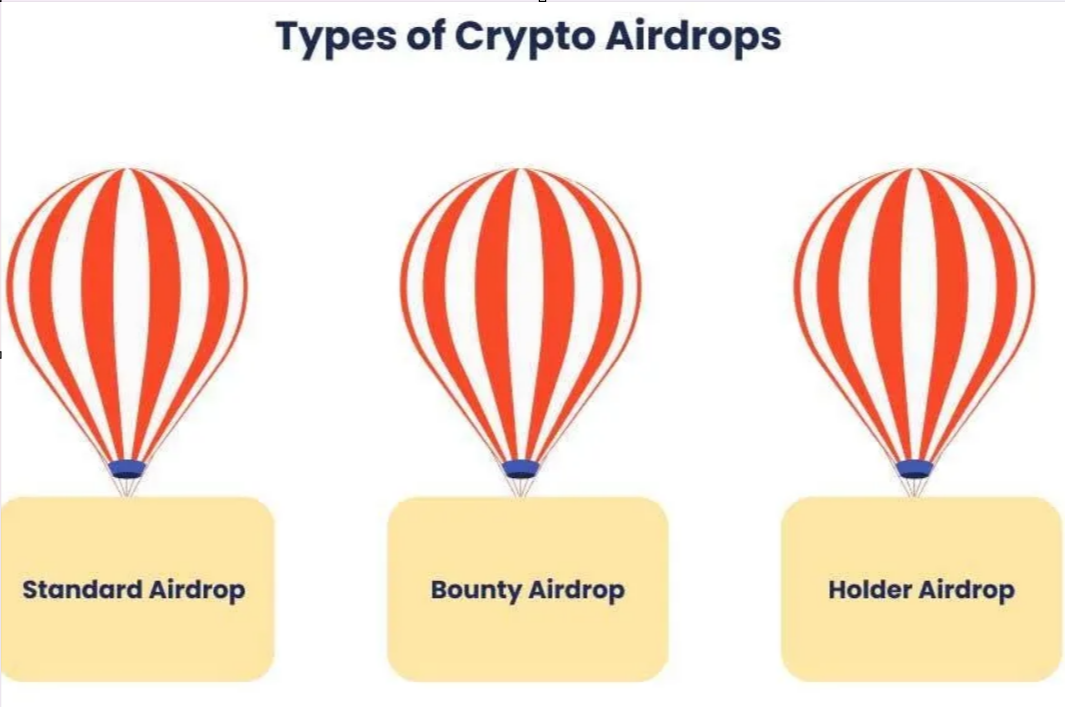In the crypto world, there are many ways to make money, and airdrops are one of the most popular methods for newbies. With the advantage of being accessible and not requiring large capital, airdrops have become an ideal start for many people. So what is an airdrop? How to participate and profit from this activity? Let's find out in the article below!

What is Airdrop?
An airdrop is a method that blockchain projects use to distribute tokens or cryptocurrencies to the community for free. This is how projects promote products, increase brand awareness, and encourage users to participate in their ecosystem.
Usually, to receive an airdrop, users only need to complete a few simple tasks such as following the project on social media, signing up for an account, or sharing content. These activities help the project build a community, create a buzz, and increase its popularity in the cryptocurrency market.
Common types of airdrops include:
- Standard Airdrop:Users receive free tokens based on simple promotional actions such as sharing articles, following the project's social networks.
- Airdrop Holder:Participants are required to hold a certain amount of tokens in their wallets to be eligible for rewards.
- Airdrop Bounty:Users perform promotional tasks such as writing posts and sharing content to receive tokens.

Who is suitable for airdrop?
Before participating in an airdrop, you need to understand that this is a form of exchanging time and effort in exchange for a certain amount of tokens. Participating in an airdrop requires patience, discipline, and the ability to evaluate potential projects.
- Market Newcomers:Airdrops are a good way for newbies to get acquainted with crypto without having to spend a large amount of capital. With some basic activities, you can get free tokens and experience the market without much risk.
- People who have a lot of free time:If you have a lot of time and are willing to take on small tasks, airdrops can bring you a side income. However, it is necessary to select prestigious and potential projects.
- Small investors:With a small investment capital, airdrops are a reasonable option because they do not require much cost but can bring good profits if you choose the right project.
Types of airdrops and how to choose a position to participate
In the crypto ecosystem, airdrops come in many different forms, each with its own advantages and disadvantages. Here are some common types of airdrops and how to choose the right one:
- DeFi (DEX, lending/borrowing...):Suitable for people who don't have a lot of time but have a relative amount of capital. Some projects require users to deposit tokens into the platform (staking) to receive rewards. It takes only a few minutes to do but the reward depends on the amount of capital spent.

- Game/NFT Airdrops:Suitable for game lovers or NFT collectors. This type of airdrop usually requires users to participate in in-game activities or own NFTs from the project. The rewards can be quite large, ranging from a few hundred to a few thousand dollars, but come with the risk of the volatile value of the NFT.
- Testnet and product testing:This type of airdrop is for people who have time and want to participate in the project's product testing. Testnet participants can help improve the quality of the product before the official launch and receive rewards for their contributions.

How is the allocation of airdrop capital reasonable?
When participating in an airdrop, allocating capital wisely will help you minimize risks and optimize profits. This is not only the allocation of money but also the management of time and effort.
- 65% for high-quality, high-potential deals: Focus on reputable projects, strong communities and clear development goals.
- 25% for high-risk markets: Some projects are potential but just launched, need time to evaluate. Although it is risky, the profit can be high if the project is successful.
- 10% reserve: This capital is reserved for unexpected opportunities. It could be a promising new project or a sudden airdrop from a project you're tracking.
- Note: It should not be spread out into too many airdrop projects, focusing on reputable odds to increase efficiency.
Prepare for newbies when participating in the Airdrop
To participate in an airdrop safely and effectively, you need to prepare a few essential things:
a. Crypto Wallet
You need a crypto wallet to receive tokens from the project. Popular wallets such as MetaMask, Trust Wallet, or wallets of major exchanges such as Binance all support airdrop token storage. Make sure the wallet supports blockchains such as Ethereum, BNB Smart Chain, or Solana.
b. Social media accounts
Many airdrops require you to interact on social media such as Twitter, Telegram, or Discord. You should have a regularly active account and be connected to crypto communities to stay up to date.
c. Email and registered account
Sign up for private emails to receive information from airdrop projects and limit spam emails. Use clean and reliable email to sign up and track notifications from projects.
d. Information security
Security is an important factor when participating in an airdrop. Never give the wallet's private key or any sensitive information to anyone.
e. Patience and organization
Airdrops are a long process and sometimes take a long time to receive tokens. Patiently monitoring and checking regularly help you not miss out on the opportunity to receive rewards.
Frequently Asked Questions About Airdrops
1.What is an airdrop and why do crypto projects do airdrops?
An airdrop is a method of distributing free tokens or cryptocurrencies from blockchain projects to attract attention, build a community, and promote a product. Projects use airdrops to reach more people, encouraging them to participate in the ecosystem and familiarize themselves with new products. This helps increase brand awareness and promote engagement on social platforms.
2.What types of airdrops are there and what is the difference between them?
Common types of airdrops include:
- Standard Airdrop: Receive free tokens for performing simple actions such as following the project's social media.
- Holder Airdrop: Requires participants to hold a specific amount of tokens in their wallets to receive rewards.
- Bounty Airdrop: Users perform promotional tasks such as writing posts and sharing content to receive tokens.
- Exclusive Airdrop: Exclusive to early participants or project support from the beginning.
- Each type of airdrop has its own requirements and benefits, allowing users to choose based on their individual needs.
3.How to know if an airdrop is reliable?
To assess the reliability of an airdrop, you can:
- Check out the development team and information about the project.
- Read reviews and consult with the community.
- Make sure that the project's website and social media provide full official information.
- Don't participate in airdrops that ask for sensitive information such as private keys.
- Follow the project's official channels to verify information.
4.Are airdrops risky? What are those risks?
Yes, participating in an airdrop can involve some risks such as:
- Scams: Some fake airdrops ask for security information or money transfers.
- Insecure token value: Not all tokens are valuable or tradable right away.
- Security risks: Sometimes, phishing links or pages can steal your information. Be careful and only participate in reputable airdrops.
5.Where can I participate in the airdrop and what do I need to prepare to participate?
You can find new airdrops on sites like AirdropAlert, CoinMarketCap, or via the project's social media channels. To participate, you need to:
- Crypto wallets: Like MetaMask or Trust Wallet to receive tokens.
- Social media accounts: To perform tasks on Twitter, Telegram, etc.
- Trusted email: To sign up for notifications.
- Information security: Do not provide private keys and only use trusted sources.